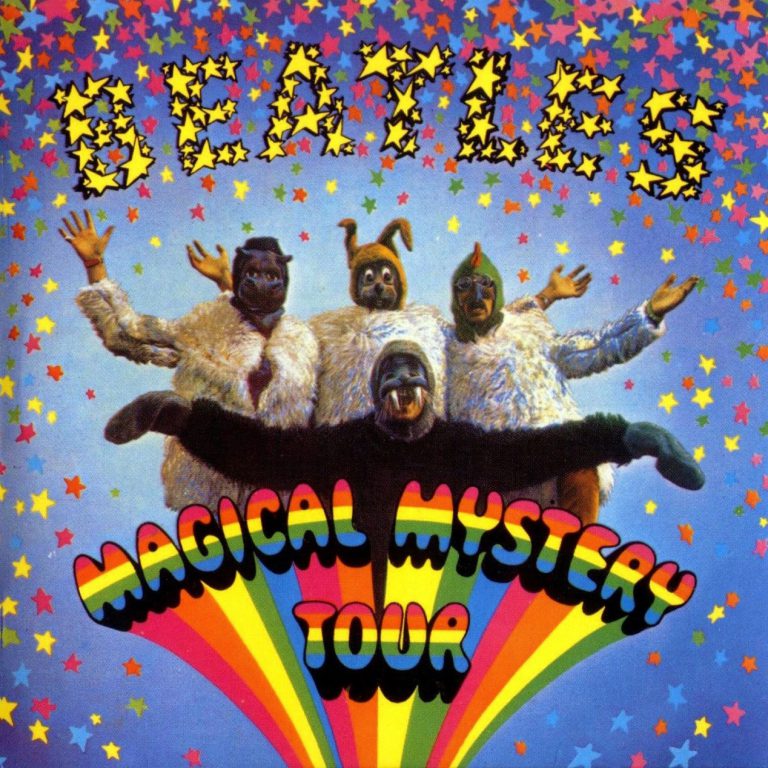
November 1967 ?
Bob Gibson creates artworks for the “Magical Mystery Tour” booklet
Last updated on April 25, 2024

November 1967 ?
Last updated on April 25, 2024
Article Oct 30, 1967 • Paul McCartney flies to France to film "Magical Mystery Tour"
Article Oct 31, 1967 • Filming of “Magical Mystery Tour” • Day 15
Article November 1967 ? • Bob Gibson creates artworks for the "Magical Mystery Tour" booklet
Interview November 1967 • The Beatles interview for Music Life
Next article Nov 03, 1967 • Filming of “Magical Mystery Tour” • Day 16
Magical Mystery Tour (TV Special)
1967 • For The Beatles • Directed by The Beatles
The Beatles recorded six original tracks for the soundtrack of their “Magical Mystery Tour” TV special. This number of songs posed a unique challenge; it was too many to accommodate on a standard 7-inch Extended Play (EP) disc, yet insufficient to occupy a full-length 12-inch Long Play (LP) record. This predicament led to an innovative solution at the dawn of November 1967: a double EP set, housed in an elegant gatefold sleeve, supplemented with a 24-page booklet.
The album cover was a departure from tradition, presenting The Beatles hidden behind animal costumes, a photograph captured during the filming of “I Am the Walrus“. This marked the first instance where the band members’ faces were obscured on any of their EP or LP releases, a daring and unique step for the group.
Included within the packaging was a comprehensive booklet, offering readers a deeper dive into the “Magical Mystery Tour“. The contents ranged from song lyrics to colour stills from the television special, captured by esteemed photographer John Kelly. In addition, it featured vibrant story illustrations drawn in the style of a comic strip by Bob Gibson, known for his work as a cartoonist for The Beatles Monthly Book. The compilation of these materials was overseen by Tony Barrow, with key contributions from Paul McCartney.
Bob Gibson also designed a full-page advertisement for “Magical Mystery Tour“, which was published in the music press.
Great. Go ahead and do what you like. Let yourself rip on it.
Paul McCartney to illustrator Bob Gibson who was showing him some rough drawings for “Magical Mystery Tour”‘. From Kensington Post – December 22, 1967
We wanted to do this because when we were young, we couldn’t think of anything to buy people for presents at that price. The only thing you could get was either ties or soap and talcum powder. But we think that the pack is a lovely present.
Paul McCartney – From “The Beatles: Off the Record” by Keith Badman, 2008
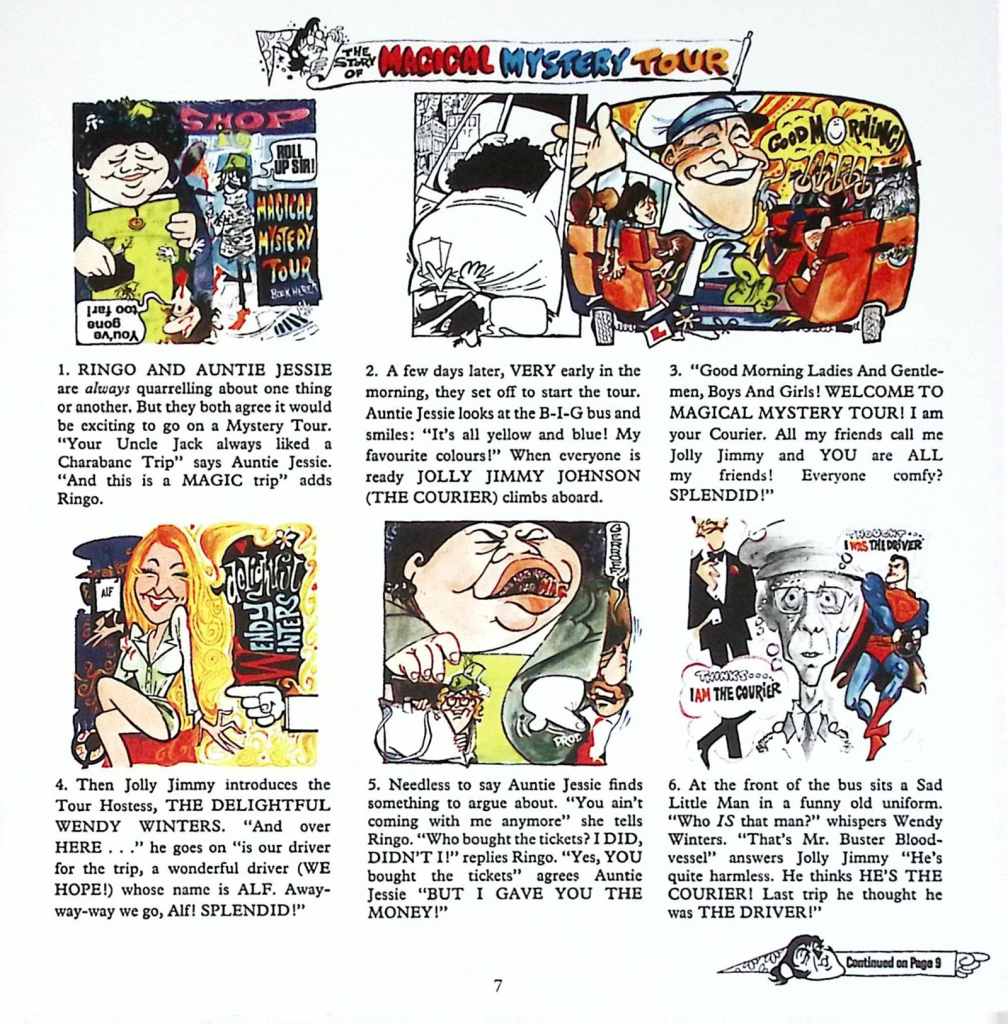
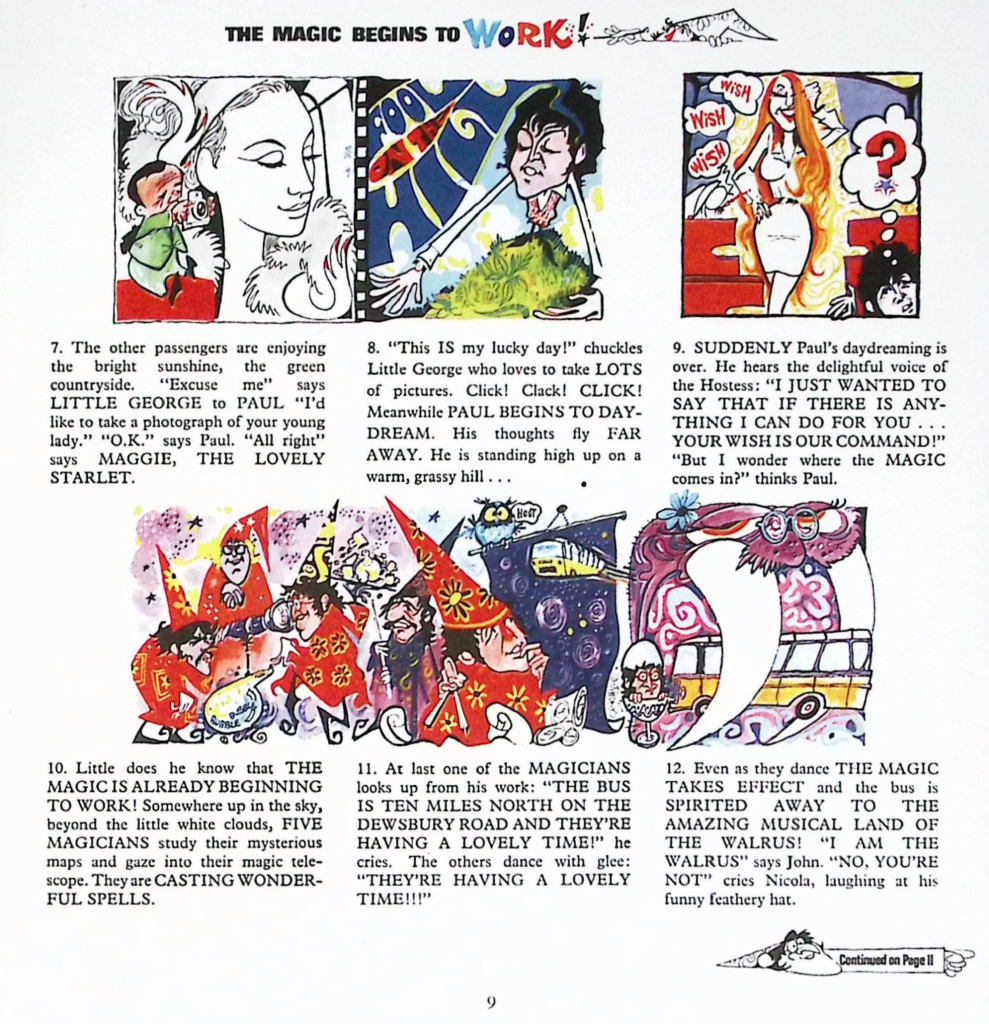
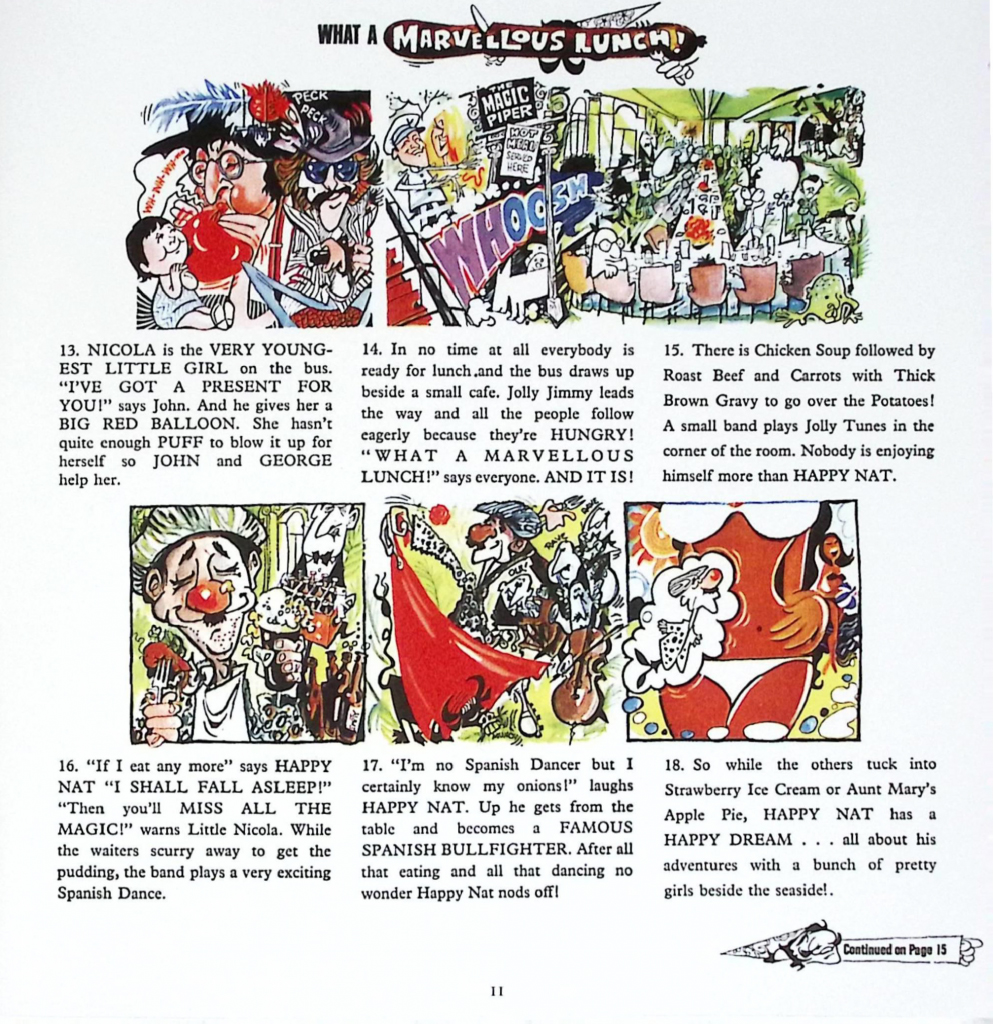
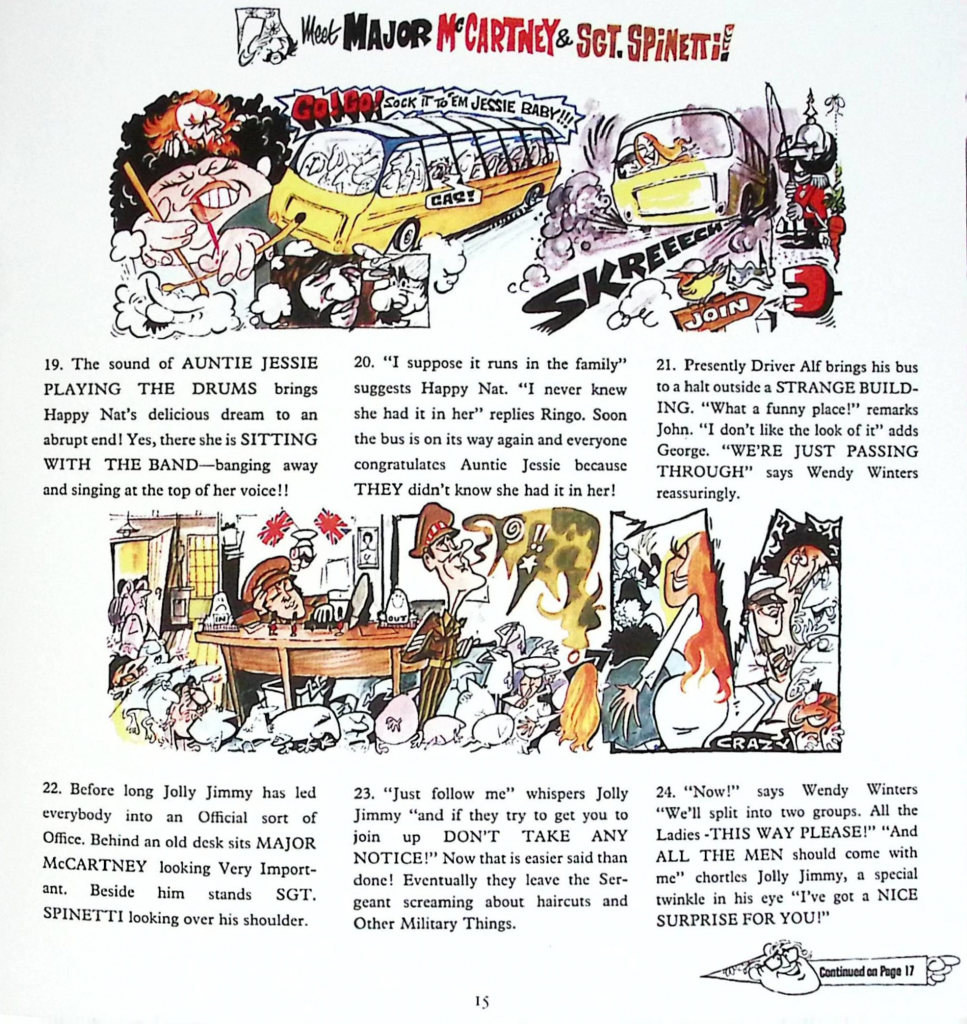
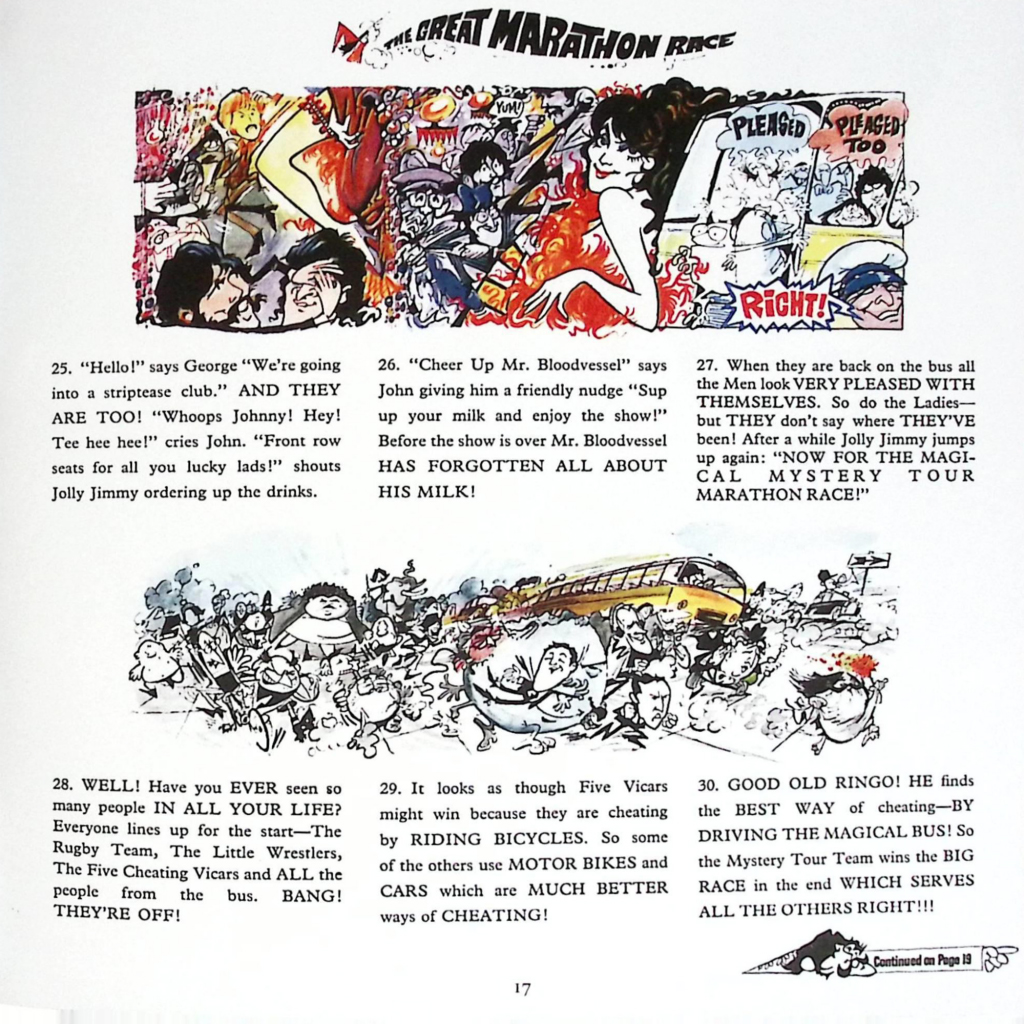
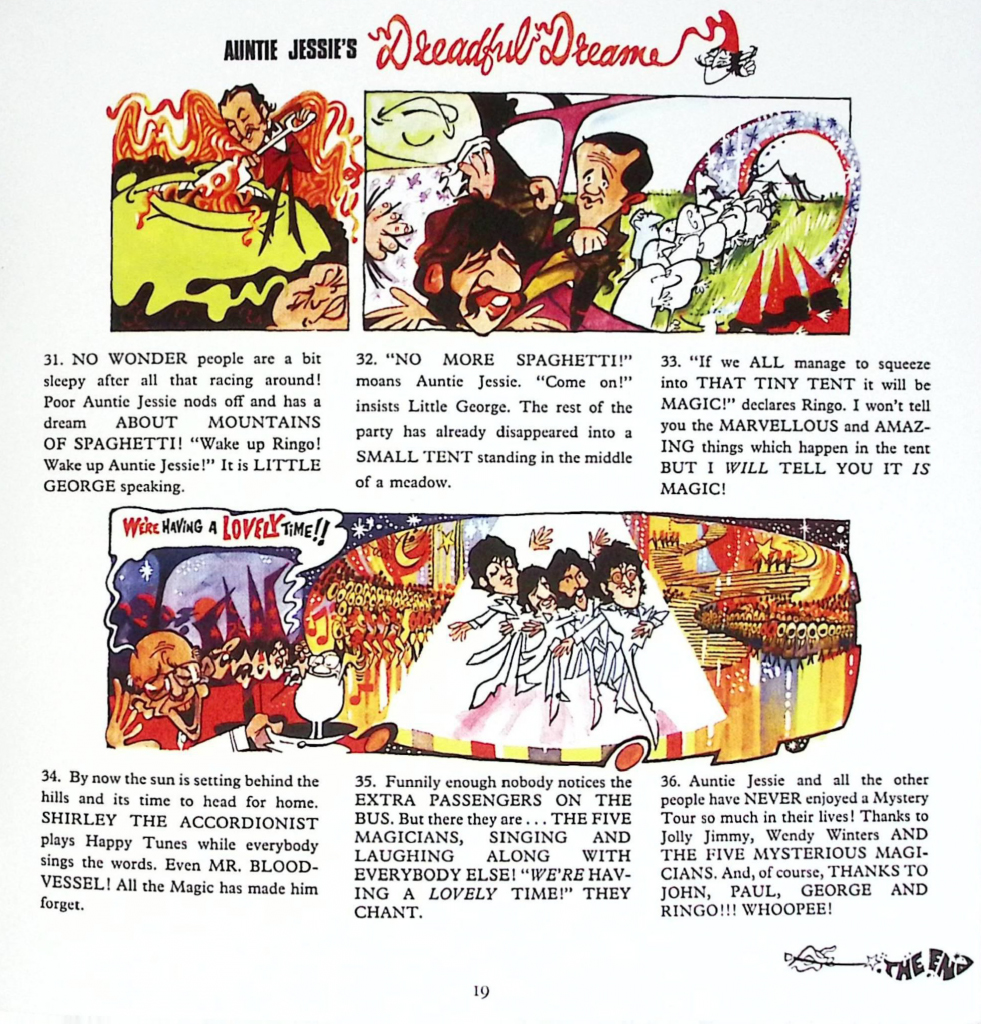
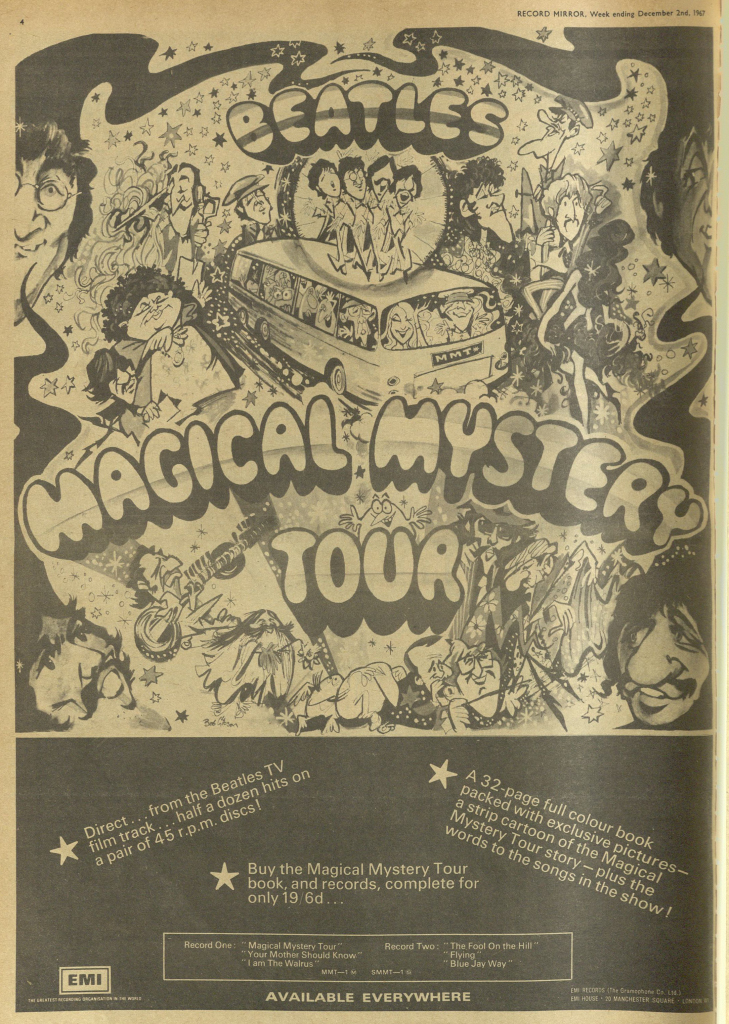
BOB GIBSON IMPRESSES THE BEATLES – AND THEY GIVE HIM HIS HEAD
“Let yourself rip” says Paul McCartney. “That’s it” says Lennon
The hungry-looking young artist you see in a self-portrait on this page is as modern as the latest psychedelic pop pressing and as traditional as the most crumbling Old Master. He is a friend of Rolling Stones and of gyrating poppets. His art can be as way-out and freaky as a Lennon lyric. His caricatures have gone beyond the sting of the satirists and the bite of the anti-war brigade to a cutting style of rebellious haymaking all his own. Yet he lives and works in a Kensington bed-sit. He has gone hungry. He has laboured menially by night to be able to draw and hawk his drawings by day. Bob Gibson is an individualist. An uncompromising Scot, he is largely but brilliantly self-taught.
His distillation of the Beatles’ Magical Mystery Tour on the front page of this newspaper was drawn exclusively for us. It will be treasured by many readers. It is representative of the art work be has created for the unique album of the same title issued a few days ago by E.M.I. and containing the latest two records by the famous foursome.
Nothing like this album has ever been put out by a disc company. It contains a zany, 32-page, all-colour booklet which includes a four-page, pull-out section with words of songs.
In addition to many pages of colour pictures the Beatles’ own TV colour film, Magical Mystery Tour, the booklet incorporates six pages of pictures in full colour, loosely based on the story of the film.
There are up to six brilliant individual drawings on each of the six pages and these — together with a hubbly-bubbly grouping of the brilliant four as magicians on the inside front cover — are all the work of Bob Gibson.
It happened this way.
About four years ago an official Beatles Monthly magazine was launched by Beat Publications Ltd. This firm was run by Sean O’Mahony, for whom Bob Gibson had been doing casual artwork for some time. O’Mahony asked Gibson to do feature headings, portraits, caricatures and cartoons of the Beatles for the new magazine and also illustrations for a book on the Beatles. These were very successful and when Paul McCartney thought up the idea for the Magical Mystery Tour booklet, he thought of Gibson’s work and considered him exactly right for the job.
“ROYAL”
The was by way of a “Royal” commission. “There was no royalty – only a flat fee – but the job was so important I would have done it for nothing. I don’t believe any modern artist in the world would have turned it down,” says Bob Gibson.
The first move, seven or eight weeks ago, was a meeting with Paul McCartney in the Wardour Preview Theatre where Bob Gibson was shown incomplete clips of the Magical Mystery Tour film the group were making for television.
Within a few days the young Kensington artist had shown some rough drawings to Paul McCartney who immediately said: “Great. Go ahead and do what you like. Let yourself rip on it.”
“I’m blessed” says Gibson, “with a photographic memory (I explain to people that there’s a wee man in my head taking pictures and storing them away for use) so I was able to recall in detail the style and treatment used in the film clips and the songs that are featured in the film. But I did not copy the film in any way. I used my own ideas entirely in my interpretations. For instance, at one point in the film there’s a delicious goon-like race in which vicars on bikes, rugby players and others compete but the Beatles win because Ringo belts ahead in the bus which is a central feature of the film.
“I saw this as a rat race and depicted it accordingly. They may not have intended it this way but that was how I saw it.
“If there is a thread at all in my strip I suppose it is anarchy – pro-Beatles and a-political — with no real allegiance to anyone or anything. I simply tumbled ideas into each box, filling every scene with confusion and — I hope – maximum interest value for children of all ages.
“In the second frame of the strip, for example, everybody is in the bus and, led by the Courier, is in a jolly Butlinish mood but I have added a greenish de Gaulle, sprawled across the floor, as a sort of perennial kill-joy.
“Anyway, the boys were so pleased they asked me to design a full-page for an advertisement in the music weeklies. I did so. Hollywood-style, and they paid me nearly as much as they did for the thirty drawings in the strip.
BREAK
“This has been a very big break for me, of course,” Bob Gibson concluded. “It’s marvellous to know that my drawings will be seen — in Beatles context — throughout the world. But this marvellous “royal” commission does not make me a courtier. I’m not trying to climb to success on their backs. I’m proudest of the fact that I was chosen – where thousands of artists would have jumped at it — not because I was cheapest or because I drew in a special way, but because mine is a style of the times; a mirror of the sort of things the Beatles are saying.”
What makes a young artist hit the hottest scene in the world of pop art in the way Bob Gibson has done?
Brought up in Glasgow, he has drawn since he can remember. Taken to see the Pinnochio film at the age of four he returned home in a trance and proceeded to draw little figures all over the walls in indelible pencil.
He was “the kiddie” at art in Woodside Secondary School – the star pupil. But because his parents were divorced and he was the only child to be with his mother he was not able to take even his “Highers” (the Scottish equivalent of the G.C.E) let alone go to Art School. When he got to 16 he had to earn a living. He began asking people how he could become an artist. Everyone was discouraging. His mother wisely reasoned that they should move to London “where the prospects are,” which they did.
Bob’s first job was cleaning out paint pots and making interminable cups of tea for artists at an exhibition-display firm. He moved to another similar firm to do the same thing but for slightly more money. Eventually, after two years, he got fed up and decided to go back to Glasgow where he was lucky enough to get a job in the advertisement department of House of Fraser, where he did lettering and was taught layouts. He came back to London after a year — “a much more valuable year than I could have had at any art school” — and returned to the drawing once at the second display firm to design exhibition stands. After a year of this, he thought his creative impulses were being blunted so he left and walked London trying to get a job in an advertising agency. No influence, so no joy!
HAWKING
Then for two years Bob Gibson tried to hawk his drawings around studios and agencies. He worked at office cleaning at nights and laboured on building sites at Marble Arch and Millbank so that he could chase work in office hours. Eventually, it was a classified advertisement that led him back into regular work. It was for a cartoonist and he got the job. Legal difficulties held this up and Gibson switched to “Pop Weekly,” so called, launched by the same firm (Robert Stigwood)… as a freelance. He had to set up photomontages and do occasional illustrations.
It was pretty much a breadline existence again. But Sean O’Mahony, one of the staff of “Pop Weekly” started his own magazine, “Beat Monthly” (still doing well as “Beat Instrumental”) and gave Bob regular work on it which kept his head above water. This was 1962 and the group scene was just beginning to happen. The Beatles were coming to the fore and O’Mahony began to produce their fan magazine also and involved Gibson from the start. He also became Bob’s agent.
As this freelancing could be done from anywhere, Bob Gibson went back to Glasgow for a time, for the good of his would, and again worked for House of Fraser. On the recommendation of their advertisement manager 18 months ago he became chief layout artist for the Barker Group of stores in Kensington High Street, which position he still holds.
He has also been doing special illustrations for this group of newspapers for some time and much appreciation has been expressed by readers at the imaginative creative quality of this work.
Bob Gibson is obviously going places. At 29, he has stormed one of the highest contemporary mountains. But he intends to follow in the footsteps of the artists he admires most – Ronald Searle, Steinberg and the late Vicky – and become a political cartoonist and social caricaturist… in an anarchistic way of his own, of course.
From Kensington Post – December 22, 1967
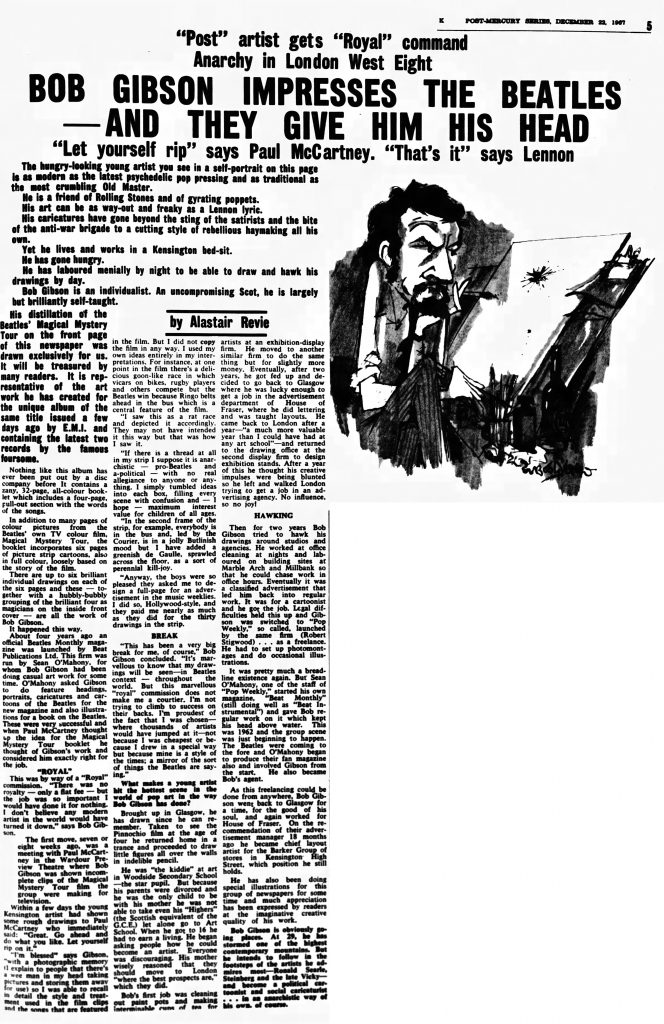
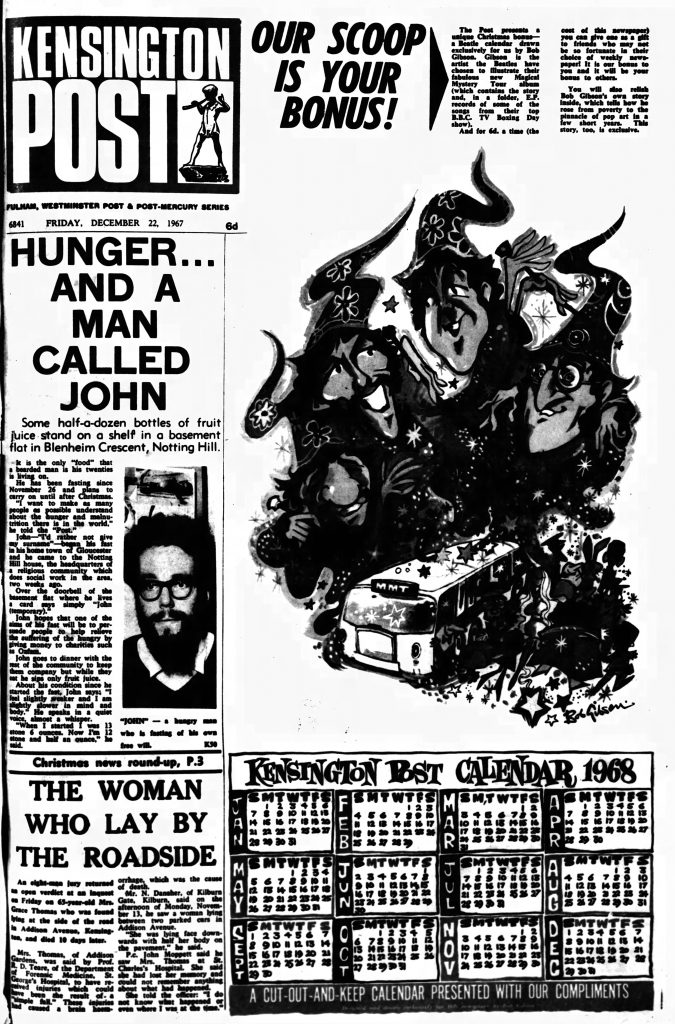
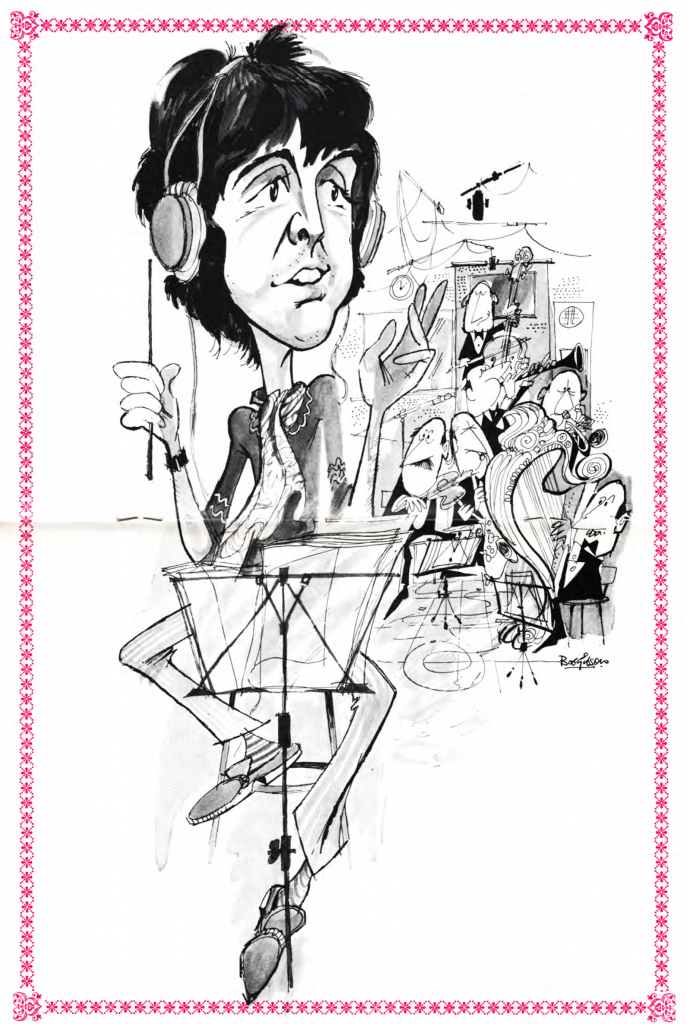
The Beatles Diary Volume 1: The Beatles Years
"With greatly expanded text, this is the most revealing and frank personal 30-year chronicle of the group ever written. Insider Barry Miles covers the Beatles story from childhood to the break-up of the group."
We owe a lot to Barry Miles for the creation of those pages, but you really have to buy this book to get all the details - a day to day chronology of what happened to the four Beatles during the Beatles years!

Notice any inaccuracies on this page? Have additional insights or ideas for new content? Or just want to share your thoughts? We value your feedback! Please use the form below to get in touch with us.